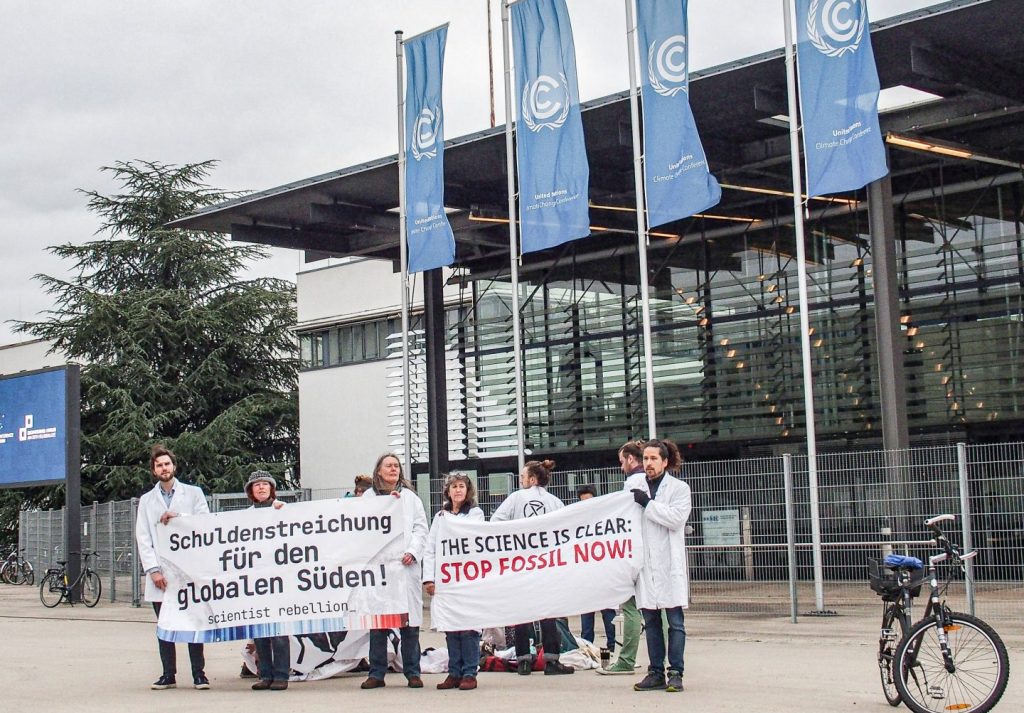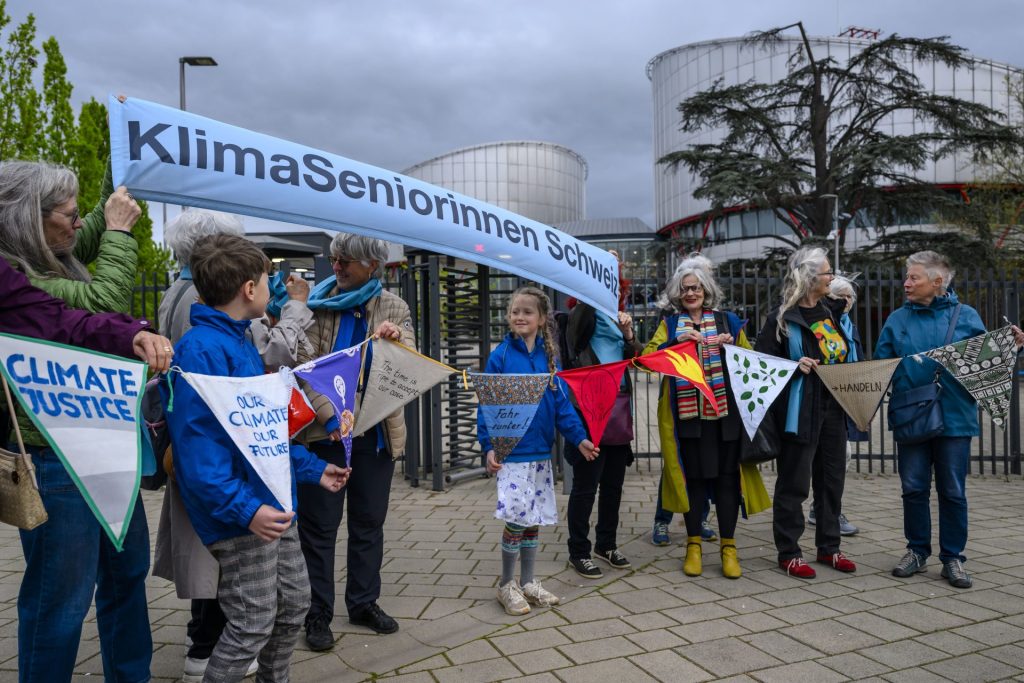Global climate finance is in a dilemma: In the coming years, hundreds of billions in financial support must flow for climate action in the Global South, while simultaneously avoiding exacerbating the debt crisis in many of these countries. This dilemma played a significant role at the climate interim conference in Bonn and will continue to do so at COP29. Today, we analyze options for how climate financing can flow without driving the countries of the Global South into ruin. Spoiler: There are solutions, but they need to be scaled quickly.
Swiss politics is also seeking a way out. After the European Court of Human Rights ruled in favor of the climate seniors and urged Switzerland to take more action on climate action, the majority of Swiss government representatives are trying to sidestep the issue. However, this could set a bad example: Switzerland should not ignore the ruling and encourage other, less democratic countries to disregard the court, warn some government representatives. Priscilla Imboden analyzes the details and highlights the debates in Switzerland.
And the ball is rolling here too: Marc Winkelmann examines the eco-balance of the European Football Championship and the role fans and their mobility will play. In today’s “Top of the Table”, we introduce you to the ten key players in the economy.


A danger is emerging in the international negotiations on the New Collective Quantified Goal (NCQG) for climate financing within the UN framework: If a large proportion of climate financing continues to flow as loans, this could exacerbate the acute debt crisis in many developing and emerging countries. At the Bonn Interim Climate Conference (June 3-13), negotiators and experts, therefore, debated ways to prevent this debt trap. However, the proposals to date are difficult to scale up, are not very reliable and could lead to new distribution conflicts.
At COP29 in Baku, the decision will be made on how high climate aid for developing countries should be starting in 2025. Developing and emerging countries are demanding up to 1.3 trillion dollars per year. However, it is unclear where the money will come from, under what conditions it will be paid and how it will flow. Several possibilities to prevent a worsening of the debt crisis were discussed:
“If the NCQG is designed incorrectly, it could exacerbate the debt problem,” says David Ryfisch, climate finance expert at Germanwatch. Many observers and negotiators in Bonn have, therefore, called for more grants and highly concessional loans. Ryfisch also believes a substantial portion of the NCQG for adaptation and loss and damage should consist of grants and concessional loans with low-interest rates and long repayment periods.
However, the budgets of donor countries are already stretched. Grants and concessional loans have accounted for only a small part of the 100 billion dollar goal. Ryfisch suggests that compromises will be needed to increase grants significantly, possibly requiring new donors to contribute, such as China and Saudi Arabia, who currently resist participating in climate finance on a UN level.
Grants and concessional loans will only constitute part of the NCQG. Many negotiators are calling for new financial sources beyond regular loans. Juan Pablo Hoffmaister of the Environmental Defense Fund suggests new sources like a CO2 tax on international shipping or a global billionaire tax proposed by Brazil at the G20 could be crucial components of the NCQG.
However, Ryfisch points out that new financial sources like a billionaire tax are not easily transferred to climate finance. The taxes and levies would be collected by states, leading to new distribution conflicts.
Gaia Larsen from the World Resources Institute (WRI) suggests debt-for-climate swaps, where indebted countries receive debt relief in exchange for investing the saved money in climate action. However, Larsen notes that debt-for-climate swaps need to be applied on a larger scale than currently practiced. “We need a global solution for debt-for-climate swaps similar to the HIPC initiative for debt relief,” she argues. Hoffmaister adds that there are possibilities to scale debt-for-climate swaps, but there are currently no concerted efforts in this direction. Development agencies are just beginning to explore these options.
It may take several years before debt-for-climate swaps become a significant instrument. Currently, there are only isolated swaps and the transaction costs are very high. Moreover, these swaps are not beneficial for countries already in debt distress, as they lack funds for debt service and therefore cannot redirect money to climate action.
Another option to relieve indebted countries could be loan clauses that allow for a pause in debt repayment during extreme weather events or other climate damages, a concept being debated as part of the NCQG. The World Bank also plans to implement such clauses more frequently, providing countries with breathing space instead of driving them deeper into a vicious cycle of climate crisis, costly extreme weather events, and debt crisis.
“We must try to ensure that the debt crisis is not exacerbated by climate finance,” says Gaia Larsen from WRI. However, it is unlikely that the debt issue can be resolved within the framework of climate negotiations. Larsen looks to other key actors: World Bank donor countries need to replenish IDA funds for the poorest countries significantly at their annual meeting. The transfer of IMF Special Drawing Rights from wealthy to poorer countries is another possibility. The G20 also needs to become more active, with Brazil proposing a billionaire tax to mobilize up to 250 billion dollars per year. Hoffmaister emphasizes the need for more coordination between various institutions like the World Bank, IMF, national banks and the climate community to prevent the NCQG from worsening the debt crisis.
The acute nature of the debt crisis is illustrated by a recent study from the “Debt Relief for a Green and Inclusive Recovery” project:
According to the study, 47 countries could become insolvent in the next five years if they invest at the levels required to meet internationally agreed climate and development goals. Another 19 countries would face liquidity problems due to the lack of fiscal space. “Enormous debt repayments are drying up funds for climate action,” warned UN Secretary-General António Guterres in a speech on World Environment Day on June 5.

On April 9, the European Court of Human Rights (ECtHR) condemned Switzerland, stating that it is not doing enough to combat climate change. The Strasbourg judges found that Switzerland is violating the human rights of the plaintiffs, the so-called “climate seniors”, affecting their right to private and family life as well as their right to a fair trial. This means Switzerland must do more to combat climate change according to the ruling.
In Switzerland, the ruling has been largely criticized. Last week, the Swiss Parliament issued a declaration titled “Effective Protection of Fundamental Rights by International Courts Instead of Judicial Activism”. This means the ECtHR should focus on human rights issues in a narrower sense, such as the prohibition of torture and that climate action is not a human right. The declaration notes that the Swiss population approved a climate action law with a net-zero target by 2050 a year ago. It calls on the federal government to “not follow the ruling further”.
The declaration is not binding for the Swiss government and has only symbolic significance. The Federal Council – the seven-member executive body – will officially respond to the ECtHR ruling after the summer break. How it will do so remains open, but a majority of government members belong to parties that do not want to accept the ruling.
The declaration is a sign that populist tendencies are also on the rise in Switzerland. Social Democratic Justice Minister Beat Jans warned Parliament against sending a signal that could encourage other, less democratic countries to disregard decisions of the Human Rights Court. He told Swiss public radio and television SRF, “We must be careful not to fall into the category of countries that do not implement decisions.” He added, “We should not set a bad example and should accept what courts say.”
There are different opinions on this issue within the Swiss government: In an initial reaction, Environment Minister Albert Rösti of the SVP said the ruling contradicts direct democracy. This argument is based on the fact that the Swiss population rejected a stricter climate action law in 2020. He also noted that the Swiss Parliament passed a new CO2 law this year. This law aims to halve CO2 emissions by 2030 compared to 1990, with measures such as emission regulations for cars and a requirement to blend sustainable fuel with kerosene. However, this is unlikely to be sufficient to implement the climate seniors ruling, especially since the law was weakened in Parliament compared to the already moderate proposal from the federal government. Environmental organizations like WWF argue that this law is not enough to fulfill Switzerland’s commitments under the Paris Climate Agreement.
Politically, reactions to Switzerland’s condemnation by the ECtHR have been mostly negative. The ruling is a scandal, said the largest party, the right-wing Swiss People’s Party (SVP), which has two government members. It is a blatant interference in the politics of a sovereign country. The SVP called for Switzerland to leave the Council of Europe, which is unlikely to gain a majority. Criticism also came from the liberal Free Democratic Party (FDP), which also has two federal councilors. The court is making politics, said the FDP. It should focus on its core task, namely protecting individuals from state overreach. The FDP has submitted a proposal in Parliament requesting that the Federal Council work with other contracting states of the European Convention on Human Rights to ensure that the ECtHR does not “limit the legitimate discretion of states through expansive interpretation of fundamental rights”. The center-right party, which has one federal councilor, also criticized the ruling. The ruling was welcomed by the Social Democratic Party, which has two representatives in the government, and the Greens, who are not represented in the government.
According to a survey, the climate seniors ruling is also viewed critically by the majority of the public. The climate seniors, however, criticize the parliamentary declaration and have already announced that they would report any potential non-implementation of the ruling to the Council of Europe. Cordelia Bär, lawyer for the climate seniors, told SRF, “We would inform the Council of Europe’s Committee of Ministers about any developments, including omissions in Switzerland, at any time.”
The lawsuit was initiated by the environmental protection association Greenpeace and the plaintiffs are the climate seniors, an association of around 2,500 retirees founded eight years ago. They sued the Swiss government and campaigned nationwide for more climate action. The Swiss Federal Court denied the seniors special standing, which means they are not entitled to sue. They then took the case to Strasbourg. The ruling could set a precedent for other climate lawsuits. It is the first time the European Court of Human Rights has stated that there is a human rights-based claim to climate action.

Philipp Lahm, the 2014 World Cup champion and Tournament Director of EURO 2024, does not want to settle for mediocrity. “We want to be a role model. We want to set standards for future major sporting events in other countries as well,” he said in March before the Parliamentary Advisory Council on Sustainable Development. He emphasized that sustainability needs to be considered in all areas.
This is no small task. An estimated 2.7 million fans will attend the 51 matches in the ten selected stadiums. The organizers expect up to twelve million visitors in the fan zones offering public viewing.
To calculate the environmental and climate impact, the Öko-Institut was commissioned with an analysis. According to the analysis:
When considering all traffic related to the EM (including visits to fan zones), researchers found that it accounts for 84 percent of all emissions. Of this, 64 percent is due to flights and 14 percent to private cars. Long-distance trains, buses and public transport together account for only six percent.
Only 16 percent of emissions are not traffic-related, with more than two-thirds coming from accommodations. In other words, more than 98 percent of total emissions occur in Scope 3, according to the study.
The study was conducted more than two years ago, before the participating teams were known or the tournament schedule could be considered. Nonetheless, the authors say the uncertainties in their calculations were manageable. Overall, the result is not far from the previous two European Championships.
To improve the ecological balance, the Öko-Institut proposed expanding public transport, using alternative fuels for airplanes, introducing a BahnCard 100 for the EM and using stadium parking lots for photovoltaic systems. Additionally, they suggested eliminating diesel generators, selling organic, vegetarian and vegan food, abolishing flyers and other giveaways, and exclusively using reusable items.
Some of these recommendations have been incorporated into the UEFA’s “ESG Strategy“. To ensure the tournament adheres to the highest sustainability standards, ticket holders can use public transport for free for 36 hours before and after each match. Long-distance travel will be cheaper and special Interrail passes for the tournament will be offered. Additionally, the availability of parking around stadiums will be reduced and the group stage matches are geographically grouped to minimize travel distances for teams. Participating national associations are also urged to travel in a low-emission manner.
The UEFA also requires renewable energy in all stadiums, reducing water consumption, offering packaging-free and low-packaging products, gender-neutral toilets, football matches for and by people with disabilities in the fan zones, “culturally diverse food”, “high-quality accessible seating”, bicycle parking in front of stadiums, a smoking ban, calls for physical activity, the introduction of sustainable procurement processes and the involvement of all stakeholders in the event.
With their measures, UEFA aims to eliminate 230,000 of the projected 490,000 tons of total CO2 emissions. For the remaining 260,000 tons, they have established a “climate fund”. Specifically, 25 euros per ton will be contributed to a fund from which German football clubs can apply for support for new solar systems or other climate action projects until the end of June. In total, seven million euros are available.
Imke Schmidt, Co-Head of the Research Area Circular Transformation at the Wuppertal Institute, believes the organizers’ sustainability strategy is generally suitable. She praises the recognition of the importance of traffic, the availability of discounted train tickets, the grouping of team travels for the group phase, and the fact that no new buildings are being constructed.
However, Schmidt argues that it is not enough. “The potential is not fully utilized. I miss the communication with the fans.” For example, information is only found on subpages of the tournament homepage. “A larger campaign would be important because the European Championship could have an impact beyond the games and bring sustainability into everyday life,” Schmidt said. She welcomes the Climate Fund, developed by the Öko-Institut and implemented by the organizers for the first time. “This approach is more effective than offsetting greenhouse gases.” Reforestation projects, for instance, cannot offset emitted emissions one-to-one and their climate impact is not as clearly calculable. The football association’s assumption that almost half of the total emissions can be avoided is seen as a “very optimistic scenario“. Fan behavior is difficult to predict. No one knows how they will act.
According to the WWF, the organizers should have set the price per ton of CO2 in the Climate Fund significantly higher than 25 euros. “The German Federal Environment Agency’s price recommendation for Germany was 237 euros per ton in 2022 and the World Bank suggested at least 80 dollars per ton,” said spokesperson Lea Vranicar. “Only with significantly higher prices can you approach the actual costs that an emitted ton of CO2 causes for society.”
The Öko-Institut originally proposed three prices between 25 and 100 euros per ton of CO2. UEFA, a signatory of the UN’s Sports for Climate Action Framework, chose the lowest price.
Whether the calculations hold up and the tournament sets global standards, as tournament chief Philipp Lahm wishes, will be evaluated afterward by the Sports University of Cologne and the University of Bielefeld in a joint project. The evaluation covers economic, social and ecological sustainability. Dekra has been commissioned for the latter part. “To achieve this, we have built a network of data providers, including EURO 2024 GmbH, stadium operators, and host cities responsible for the fan zones,” said Moritz Weißleder, Product Manager for Sustainability in Sports and Events at Dekra. The main effort is focused on mobility. “We will determine how visitors travel and where they stay through online and on-site surveys.” They aim to interview between two and five percent of fan zone visitors for meaningful results.
It is already clear that sustainability does not have high priority everywhere in football. According to the NGO Transport & Environment, all foreign associations except Switzerland have not committed to traveling to Germany by train. And the world football federation FIFA decided to host the 2026 World Cup in three countries and the 2030 World Cup in six nations on three continents. Therefore, transport emissions at these tournaments are likely to increase further.
On Monday, the member states in the EU Environment Council voted by a qualified majority for the EU Nature Restoration Law. This was made possible by a solo decision from Austrian Climate Action Minister Leonore Gewessler (Green Party), who supported the law despite protests from her coalition partner, the conservative ÖVP. While the coalition in Austria is crumbling, the path is now clear after two years and 136 amendments to the text of the law to restore at least 20 percent of land areas in the EU by 2030.
Gewessler justified her stance by pointing to the increased flood risks due to climate change: “When it rains, water doesn’t seep through asphalt.” In response to her solo action, the ÖVP filed a criminal complaint against Gewessler on Monday for abuse of office. They also plan to file a nullity action with the European Court of Justice (ECJ). A legal opinion commissioned by the ÖVP-led Ministry of Agriculture, among others, has deemed Gewessler’s action unlawful. The Constitutional Service of the Federal Chancellery also reached this conclusion, said Chancellor Karl Nehammer (ÖVP) at a press conference on Monday evening. However, he wants to continue the coalition to prevent the country from “falling into chaos”.
All this is “legal terra incognita,” said Walter Obwexer, an expert in European constitutional law at the University of Innsbruck, to the Austria Press Agency (APA). There is a “fair chance” that the Council’s decision will be overturned by the ECJ due to procedural errors. A decision is expected in about a year and a half. However, Obwexer assumes that the decision will be published in the official text and that the regulations will come into force – at least temporarily.
Constitutional lawyer Peter Bußjäger, also from the University of Innsbruck, described the legal situation to the APA as complex. He considers neither the threatened nullity action nor Gewessler’s approval to be conclusive. Gewessler, on the other hand, relies on four legal opinions and consultations with several lawyers, including Daniel Ennöckl from BOKU University in Vienna, who sees her actions as legally sound. The Green Party is calm in the face of potential legal challenges. The EU Council Presidency also considers Gewessler’s approval to be valid.
In an initial reaction, Jutta Paulus, the lead negotiator for the Green Group in the European Parliament and a German MEP, called it a success in the fight against species extinction and the consequences of the climate crisis. Environmental organizations like Greenpeace and WWF also welcomed the law. Previously, thousands of scientists had already supported it in an open letter.
Federal Environment Minister Steffi Lemke spoke of a “balanced compromise of all interests”. In March, the German government agreed to approve the law after protests from the FDP but pushed for relief for farmers. Opposition came from Finland, Sweden, Italy, Hungary, Poland and the Netherlands. The European People’s Party (EPP), parts of the right-wing and far-right, and some farmers’ associations also criticized the law-sometimes with spurious arguments. Jan-Christoph Oetjen, the FDP’s agricultural policy spokesman and Vice President of the European Parliament, called it a “step backward.” dpa/lb
The CDU has reversed its earlier stance, where it promised to completely halt the revised Building Energy Act (GEG) passed by the coalition last year if they won the election. According to party insiders, only minor adjustments are now planned, with details currently being worked out. When the law was passed last September, CDU leader Friedrich Merz declared, “We will repeal this heating law.” Vice Chairman Jens Spahn criticized an alleged “heat pump mandate” with costs purportedly between “80,000 to 100,000 euros,” and the party launched an online petition against the coalition’s “heating hammer”.
The tone has now markedly shifted. At the opening of the “Heat Pump Academy”, where Enpal trains installation helpers, Merz expressed clear support: “We, the Union, fully back this heat transition,” the CDU leader stated. He also endorsed heat pump technology as “fascinating” and “a crucial component for this transformation”. Representatives from Enpal and Bosch, a heat pump manufacturer, emphasized that they did not support the idea of repealing the long-debated law. Enpal CEO Mario Kohle stated, “We want reliability, clarity and planning security from politics,” a sentiment that is gaining traction.
When asked about specific changes the CDU wants for the GEG, Andreas Jung, the party’s climate policy vice chairman, told Table.Briefings: “We will discard the burdensome overregulation that the coalition’s heating law has added to the GEG.” The law should allow for various technologies, including “connections to a heating network, heat pumps, solar thermal energy, geothermal energy, wood pellets and gas heating systems that can be converted to biomethane or hydrogen,” Jung explained. However, these options are already included in the current law. Another demand Jung mentioned is to fully equate the promotion of pellet heating systems with heat pumps. mkr
Currently, plans exist to shut down one-tenth of the world’s coal power plants by 2030. However, a new study reveals that in developing countries alone, 800 coal power plants – amounting to one-third of all coal plants globally – could be profitably closed and replaced by clean solar energy. There are approximately 2,400 coal power plants in operation worldwide, producing 15.5 billion tons of CO2 emissions annually.
The main challenge, according to the report by the Institute for Energy Economics and Financial Analysis (IEEFA), is that many plants still have debts to repay or are bound by long-term power purchase agreements for decades. There are currently few “well-defined, contractually specified, bankable” plans for transitioning from coal to clean energy, according to Paul Jacobson, the report’s lead author. Governments should explore new opportunities, such as the Asian Development Bank’s Energy Transition Mechanism.
Of the 800 coal power plants identified by the IEEFA, about 600 were built 30 or more years ago. Many of these have already repaid their loans and are no longer tied to long-term power purchase agreements. Since the profit margins for renewables are now sufficient, coal power plants built just 15 to 30 years ago could also be replaced. However, obstacles such as fossil fuel subsidies need to be dismantled to facilitate this transition. rtr/lb
The EU holds substantial potential to decrease emissions stemming from consumption. This requires targeted measures to reduce consumption-based CO2 emissions (CBEs) as well as a reduction in overall consumption, as concluded by a study from the Stockholm Environment Institute (SEI).
Historically, political actions have primarily focused on territorial emissions from industrial production and energy, neglecting the impacts of consumption. CBEs originating from the EU account for approximately nine percent of global emissions.
The study identifies food, housing and mobility as areas with particularly high consumption-related emissions and significant potential for reductions. While individual EU member states have shown considerable effort, coordinated actions at the EU level have been lacking. These actions should not only emphasize efficiency gains but also consider reducing consumption and promoting sufficiency.
According to the report, “imported emissions” are a key problem: The EU has been a net importer of CO2 emissions since 2015. The emissions that it imports via goods and services exceed those that it exports. European consumption therefore has a negative impact on other countries. Most emissions are imported from China. In order to reduce consumption-related emissions, emissions from complex supply chains must therefore also be tackled and more transparency created.
The report highlights significant disparities in consumption-related emissions among EU member states. For instance, while Denmark and Luxembourg register around 11 tons of CO2e per capita, Slovakia records only 4.6 tons. Germany stands at 9 tons CO2e, with the EU average at 8.1 tons. kul


Majid al Suwaidi – CEO, Altérra
Majid al Suwaidi has been tasked with financing the global energy transition. He is the CEO of Altérra, an investment fund founded at COP28 in Dubai in 2023, making it the largest private climate fund worldwide. Altérra aims to mobilize a total of 250 billion dollars in climate financing for developing and emerging countries by 2030, including investments in renewable energy and industrial decarbonization. Al Suwaidi is an experienced diplomat. He served as the Director-General of COP28, led negotiations for the UAE at the Paris Climate Summit, and was Ambassador to Spain and the Vatican, as well as Consul General in New York. Early in his career, the geologist and earth scientist worked for Abu Dhabi’s state oil producer, ADNOC.

Markus Krebber – CEO, RWE
RWE has long been synonymous with the old energy world of nuclear power, coal and gas. However, this is changing rapidly: While the energy giant from the Rhineland, with its lignite power plants, remains one of the country’s largest CO2 emitters, this will soon come to an end. Unlike the East German LEAG, RWE has agreed with the coalition government to phase out coal by 2030 under Krebber‘s leadership. The economist, who joined RWE in 2012 and previously worked for Commerzbank and McKinsey, has repeatedly rejected calls for longer nuclear power plant operations. Instead, the company is massively investing in wind and solar energy and pushing for hydrogen-ready gas power plants to be operational in time for the coal phase-out.

Gunter Erfurt – CEO, Meyer Burger
Meyer Burger was the last major manufacturer in Germany – in Freiberg, Saxony – producing solar modules. Due to significantly cheaper competition from China, the company recently faced economic difficulties. At the beginning of the year, Gunter Erfurt called for public support and made the continued operation of the plant dependent on it. When the federal government definitively refused in March, he announced the closure of the Freiberg plant. At Table.Today, he called for “fair competitive conditions” for the industry. Erfurt has worked in the solar industry for over two decades and has been CEO of Meyer Burger since 2020.

Wael Sawan – CEO, Shell
Since taking office as CEO in January 2023, Wael Sawan has slowed down Shell’s green transformation. He has provided the company with an updated energy transition strategy, which shareholders accepted in May: the goal of reducing the company’s CO2 intensity by 45 percent by 2035 was dropped. In the summer of 2023, Sawan abandoned the company’s climate target of reducing oil production by 20 percent by 2030. Previously, he had canceled investments in several offshore wind, hydrogen and biofuel projects.

Chuanfu Wang – CEO, BYD
Chuanfu Wang, 58, is the CEO of BYD, the world’s largest electric vehicle manufacturer. With his company, Wang initiated the mobility transition in China and has been targeting the global market for several years. Last year, BYD sold three million cars worldwide, making it one of the ten largest car manufacturers. BYD is building its first European plant in Hungary. BYD is also a leader in electric buses. Wang founded the company at the age of 29, initially producing mobile phone batteries. Since 2003, BYD has been manufacturing cars. In 2022, BYD ceased production of internal combustion engine vehicles. Wang holds a master’s degree in battery technology and is an 18-time billionaire.

Carsten Spohr – Chairman of the Executive Board, Lufthansa
Carsten Spohr has been CEO of Deutsche Lufthansa since 2014 and works in an industry expected to grow significantly. He must transform the company to achieve climate neutrality in the medium term. While Spohr believes in climate-neutral flying, he criticizes European climate protection regulations for aviation: The requirement to blend a certain proportion of synthetic fuels (SAF) is hindered by a limited market supply, leading to increased costs. SAFs currently make up 0.2 percent of Lufthansa’s fuel. Spohr is a trained engineer and pilot.

Bernhard Osburg – CEO, Thyssenkrupp Steel
Bernhard Osburg must lead the green transformation of Thyssenkrupp Steel, one of Germany’s largest CO2 emitters. The steel producer is responsible for around 2.5 percent of German emissions. In Duisburg, direct reduction plants are being built to use hydrogen instead of coal starting in 2029. The public sector is funding the plants with up to two billion euros. The green transformation is costly, and the plants are already underutilized.

Nils Aldag – Founder and CEO, Sunfire
With his Dresden-based company Sunfire, Nils Aldag is generating great hopes for a climate-friendly future for German industry. Sunfire, co-founded by Aldag and Christian von Olshausen in 2010, manufactures electrolyzers: large, cylindrical steel machines that split water into oxygen and hydrogen using electrified membranes. If the electricity comes from renewable sources, this process is free of greenhouse gas emissions. Sectors that are difficult to decarbonize, such as the steel industry or basic chemicals, will rely on this green hydrogen in the future. Aldag, who studied business administration and business law, recently stated in an interview with Table.Briefings: “We are in an industry where all arrows point upward.”

Dominik von Achten – CEO, Heidelberg Materials
The cement sector is one of the world’s largest CO2 emitters. Dominik von Achten aims to make Heidelberg Materials a leader in the decarbonization of the industry. In 2022, the company was renamed from Heidelberg Cement to Heidelberg Materials, leading many to accuse the company of greenwashing. In the first half of 2025, the company plans to bring the first net-zero cement to market, with CO2 from production to be captured and stored under the Norwegian seabed using CCS. Previously, von Achten worked at Boston Consulting Group. He has been with Heidelberg Materials since 2007 and CEO since 2020.

Markus Kamieth – Chairman of the Board of Executive Directors, BASF
Markus Kamieth has been with BASF for 25 years in various roles and recently became the head of the chemical giant. He has ambitious plans: He announced at the start of his tenure that BASF should become “the preferred company for the green transformation of customers”. This is to be achieved by taking a leading role in battery production and transitioning to renewable raw materials and chemical recycling. Despite some criticism, the company continues to make significant investments in China.
Global climate finance is in a dilemma: In the coming years, hundreds of billions in financial support must flow for climate action in the Global South, while simultaneously avoiding exacerbating the debt crisis in many of these countries. This dilemma played a significant role at the climate interim conference in Bonn and will continue to do so at COP29. Today, we analyze options for how climate financing can flow without driving the countries of the Global South into ruin. Spoiler: There are solutions, but they need to be scaled quickly.
Swiss politics is also seeking a way out. After the European Court of Human Rights ruled in favor of the climate seniors and urged Switzerland to take more action on climate action, the majority of Swiss government representatives are trying to sidestep the issue. However, this could set a bad example: Switzerland should not ignore the ruling and encourage other, less democratic countries to disregard the court, warn some government representatives. Priscilla Imboden analyzes the details and highlights the debates in Switzerland.
And the ball is rolling here too: Marc Winkelmann examines the eco-balance of the European Football Championship and the role fans and their mobility will play. In today’s “Top of the Table”, we introduce you to the ten key players in the economy.


A danger is emerging in the international negotiations on the New Collective Quantified Goal (NCQG) for climate financing within the UN framework: If a large proportion of climate financing continues to flow as loans, this could exacerbate the acute debt crisis in many developing and emerging countries. At the Bonn Interim Climate Conference (June 3-13), negotiators and experts, therefore, debated ways to prevent this debt trap. However, the proposals to date are difficult to scale up, are not very reliable and could lead to new distribution conflicts.
At COP29 in Baku, the decision will be made on how high climate aid for developing countries should be starting in 2025. Developing and emerging countries are demanding up to 1.3 trillion dollars per year. However, it is unclear where the money will come from, under what conditions it will be paid and how it will flow. Several possibilities to prevent a worsening of the debt crisis were discussed:
“If the NCQG is designed incorrectly, it could exacerbate the debt problem,” says David Ryfisch, climate finance expert at Germanwatch. Many observers and negotiators in Bonn have, therefore, called for more grants and highly concessional loans. Ryfisch also believes a substantial portion of the NCQG for adaptation and loss and damage should consist of grants and concessional loans with low-interest rates and long repayment periods.
However, the budgets of donor countries are already stretched. Grants and concessional loans have accounted for only a small part of the 100 billion dollar goal. Ryfisch suggests that compromises will be needed to increase grants significantly, possibly requiring new donors to contribute, such as China and Saudi Arabia, who currently resist participating in climate finance on a UN level.
Grants and concessional loans will only constitute part of the NCQG. Many negotiators are calling for new financial sources beyond regular loans. Juan Pablo Hoffmaister of the Environmental Defense Fund suggests new sources like a CO2 tax on international shipping or a global billionaire tax proposed by Brazil at the G20 could be crucial components of the NCQG.
However, Ryfisch points out that new financial sources like a billionaire tax are not easily transferred to climate finance. The taxes and levies would be collected by states, leading to new distribution conflicts.
Gaia Larsen from the World Resources Institute (WRI) suggests debt-for-climate swaps, where indebted countries receive debt relief in exchange for investing the saved money in climate action. However, Larsen notes that debt-for-climate swaps need to be applied on a larger scale than currently practiced. “We need a global solution for debt-for-climate swaps similar to the HIPC initiative for debt relief,” she argues. Hoffmaister adds that there are possibilities to scale debt-for-climate swaps, but there are currently no concerted efforts in this direction. Development agencies are just beginning to explore these options.
It may take several years before debt-for-climate swaps become a significant instrument. Currently, there are only isolated swaps and the transaction costs are very high. Moreover, these swaps are not beneficial for countries already in debt distress, as they lack funds for debt service and therefore cannot redirect money to climate action.
Another option to relieve indebted countries could be loan clauses that allow for a pause in debt repayment during extreme weather events or other climate damages, a concept being debated as part of the NCQG. The World Bank also plans to implement such clauses more frequently, providing countries with breathing space instead of driving them deeper into a vicious cycle of climate crisis, costly extreme weather events, and debt crisis.
“We must try to ensure that the debt crisis is not exacerbated by climate finance,” says Gaia Larsen from WRI. However, it is unlikely that the debt issue can be resolved within the framework of climate negotiations. Larsen looks to other key actors: World Bank donor countries need to replenish IDA funds for the poorest countries significantly at their annual meeting. The transfer of IMF Special Drawing Rights from wealthy to poorer countries is another possibility. The G20 also needs to become more active, with Brazil proposing a billionaire tax to mobilize up to 250 billion dollars per year. Hoffmaister emphasizes the need for more coordination between various institutions like the World Bank, IMF, national banks and the climate community to prevent the NCQG from worsening the debt crisis.
The acute nature of the debt crisis is illustrated by a recent study from the “Debt Relief for a Green and Inclusive Recovery” project:
According to the study, 47 countries could become insolvent in the next five years if they invest at the levels required to meet internationally agreed climate and development goals. Another 19 countries would face liquidity problems due to the lack of fiscal space. “Enormous debt repayments are drying up funds for climate action,” warned UN Secretary-General António Guterres in a speech on World Environment Day on June 5.

On April 9, the European Court of Human Rights (ECtHR) condemned Switzerland, stating that it is not doing enough to combat climate change. The Strasbourg judges found that Switzerland is violating the human rights of the plaintiffs, the so-called “climate seniors”, affecting their right to private and family life as well as their right to a fair trial. This means Switzerland must do more to combat climate change according to the ruling.
In Switzerland, the ruling has been largely criticized. Last week, the Swiss Parliament issued a declaration titled “Effective Protection of Fundamental Rights by International Courts Instead of Judicial Activism”. This means the ECtHR should focus on human rights issues in a narrower sense, such as the prohibition of torture and that climate action is not a human right. The declaration notes that the Swiss population approved a climate action law with a net-zero target by 2050 a year ago. It calls on the federal government to “not follow the ruling further”.
The declaration is not binding for the Swiss government and has only symbolic significance. The Federal Council – the seven-member executive body – will officially respond to the ECtHR ruling after the summer break. How it will do so remains open, but a majority of government members belong to parties that do not want to accept the ruling.
The declaration is a sign that populist tendencies are also on the rise in Switzerland. Social Democratic Justice Minister Beat Jans warned Parliament against sending a signal that could encourage other, less democratic countries to disregard decisions of the Human Rights Court. He told Swiss public radio and television SRF, “We must be careful not to fall into the category of countries that do not implement decisions.” He added, “We should not set a bad example and should accept what courts say.”
There are different opinions on this issue within the Swiss government: In an initial reaction, Environment Minister Albert Rösti of the SVP said the ruling contradicts direct democracy. This argument is based on the fact that the Swiss population rejected a stricter climate action law in 2020. He also noted that the Swiss Parliament passed a new CO2 law this year. This law aims to halve CO2 emissions by 2030 compared to 1990, with measures such as emission regulations for cars and a requirement to blend sustainable fuel with kerosene. However, this is unlikely to be sufficient to implement the climate seniors ruling, especially since the law was weakened in Parliament compared to the already moderate proposal from the federal government. Environmental organizations like WWF argue that this law is not enough to fulfill Switzerland’s commitments under the Paris Climate Agreement.
Politically, reactions to Switzerland’s condemnation by the ECtHR have been mostly negative. The ruling is a scandal, said the largest party, the right-wing Swiss People’s Party (SVP), which has two government members. It is a blatant interference in the politics of a sovereign country. The SVP called for Switzerland to leave the Council of Europe, which is unlikely to gain a majority. Criticism also came from the liberal Free Democratic Party (FDP), which also has two federal councilors. The court is making politics, said the FDP. It should focus on its core task, namely protecting individuals from state overreach. The FDP has submitted a proposal in Parliament requesting that the Federal Council work with other contracting states of the European Convention on Human Rights to ensure that the ECtHR does not “limit the legitimate discretion of states through expansive interpretation of fundamental rights”. The center-right party, which has one federal councilor, also criticized the ruling. The ruling was welcomed by the Social Democratic Party, which has two representatives in the government, and the Greens, who are not represented in the government.
According to a survey, the climate seniors ruling is also viewed critically by the majority of the public. The climate seniors, however, criticize the parliamentary declaration and have already announced that they would report any potential non-implementation of the ruling to the Council of Europe. Cordelia Bär, lawyer for the climate seniors, told SRF, “We would inform the Council of Europe’s Committee of Ministers about any developments, including omissions in Switzerland, at any time.”
The lawsuit was initiated by the environmental protection association Greenpeace and the plaintiffs are the climate seniors, an association of around 2,500 retirees founded eight years ago. They sued the Swiss government and campaigned nationwide for more climate action. The Swiss Federal Court denied the seniors special standing, which means they are not entitled to sue. They then took the case to Strasbourg. The ruling could set a precedent for other climate lawsuits. It is the first time the European Court of Human Rights has stated that there is a human rights-based claim to climate action.

Philipp Lahm, the 2014 World Cup champion and Tournament Director of EURO 2024, does not want to settle for mediocrity. “We want to be a role model. We want to set standards for future major sporting events in other countries as well,” he said in March before the Parliamentary Advisory Council on Sustainable Development. He emphasized that sustainability needs to be considered in all areas.
This is no small task. An estimated 2.7 million fans will attend the 51 matches in the ten selected stadiums. The organizers expect up to twelve million visitors in the fan zones offering public viewing.
To calculate the environmental and climate impact, the Öko-Institut was commissioned with an analysis. According to the analysis:
When considering all traffic related to the EM (including visits to fan zones), researchers found that it accounts for 84 percent of all emissions. Of this, 64 percent is due to flights and 14 percent to private cars. Long-distance trains, buses and public transport together account for only six percent.
Only 16 percent of emissions are not traffic-related, with more than two-thirds coming from accommodations. In other words, more than 98 percent of total emissions occur in Scope 3, according to the study.
The study was conducted more than two years ago, before the participating teams were known or the tournament schedule could be considered. Nonetheless, the authors say the uncertainties in their calculations were manageable. Overall, the result is not far from the previous two European Championships.
To improve the ecological balance, the Öko-Institut proposed expanding public transport, using alternative fuels for airplanes, introducing a BahnCard 100 for the EM and using stadium parking lots for photovoltaic systems. Additionally, they suggested eliminating diesel generators, selling organic, vegetarian and vegan food, abolishing flyers and other giveaways, and exclusively using reusable items.
Some of these recommendations have been incorporated into the UEFA’s “ESG Strategy“. To ensure the tournament adheres to the highest sustainability standards, ticket holders can use public transport for free for 36 hours before and after each match. Long-distance travel will be cheaper and special Interrail passes for the tournament will be offered. Additionally, the availability of parking around stadiums will be reduced and the group stage matches are geographically grouped to minimize travel distances for teams. Participating national associations are also urged to travel in a low-emission manner.
The UEFA also requires renewable energy in all stadiums, reducing water consumption, offering packaging-free and low-packaging products, gender-neutral toilets, football matches for and by people with disabilities in the fan zones, “culturally diverse food”, “high-quality accessible seating”, bicycle parking in front of stadiums, a smoking ban, calls for physical activity, the introduction of sustainable procurement processes and the involvement of all stakeholders in the event.
With their measures, UEFA aims to eliminate 230,000 of the projected 490,000 tons of total CO2 emissions. For the remaining 260,000 tons, they have established a “climate fund”. Specifically, 25 euros per ton will be contributed to a fund from which German football clubs can apply for support for new solar systems or other climate action projects until the end of June. In total, seven million euros are available.
Imke Schmidt, Co-Head of the Research Area Circular Transformation at the Wuppertal Institute, believes the organizers’ sustainability strategy is generally suitable. She praises the recognition of the importance of traffic, the availability of discounted train tickets, the grouping of team travels for the group phase, and the fact that no new buildings are being constructed.
However, Schmidt argues that it is not enough. “The potential is not fully utilized. I miss the communication with the fans.” For example, information is only found on subpages of the tournament homepage. “A larger campaign would be important because the European Championship could have an impact beyond the games and bring sustainability into everyday life,” Schmidt said. She welcomes the Climate Fund, developed by the Öko-Institut and implemented by the organizers for the first time. “This approach is more effective than offsetting greenhouse gases.” Reforestation projects, for instance, cannot offset emitted emissions one-to-one and their climate impact is not as clearly calculable. The football association’s assumption that almost half of the total emissions can be avoided is seen as a “very optimistic scenario“. Fan behavior is difficult to predict. No one knows how they will act.
According to the WWF, the organizers should have set the price per ton of CO2 in the Climate Fund significantly higher than 25 euros. “The German Federal Environment Agency’s price recommendation for Germany was 237 euros per ton in 2022 and the World Bank suggested at least 80 dollars per ton,” said spokesperson Lea Vranicar. “Only with significantly higher prices can you approach the actual costs that an emitted ton of CO2 causes for society.”
The Öko-Institut originally proposed three prices between 25 and 100 euros per ton of CO2. UEFA, a signatory of the UN’s Sports for Climate Action Framework, chose the lowest price.
Whether the calculations hold up and the tournament sets global standards, as tournament chief Philipp Lahm wishes, will be evaluated afterward by the Sports University of Cologne and the University of Bielefeld in a joint project. The evaluation covers economic, social and ecological sustainability. Dekra has been commissioned for the latter part. “To achieve this, we have built a network of data providers, including EURO 2024 GmbH, stadium operators, and host cities responsible for the fan zones,” said Moritz Weißleder, Product Manager for Sustainability in Sports and Events at Dekra. The main effort is focused on mobility. “We will determine how visitors travel and where they stay through online and on-site surveys.” They aim to interview between two and five percent of fan zone visitors for meaningful results.
It is already clear that sustainability does not have high priority everywhere in football. According to the NGO Transport & Environment, all foreign associations except Switzerland have not committed to traveling to Germany by train. And the world football federation FIFA decided to host the 2026 World Cup in three countries and the 2030 World Cup in six nations on three continents. Therefore, transport emissions at these tournaments are likely to increase further.
On Monday, the member states in the EU Environment Council voted by a qualified majority for the EU Nature Restoration Law. This was made possible by a solo decision from Austrian Climate Action Minister Leonore Gewessler (Green Party), who supported the law despite protests from her coalition partner, the conservative ÖVP. While the coalition in Austria is crumbling, the path is now clear after two years and 136 amendments to the text of the law to restore at least 20 percent of land areas in the EU by 2030.
Gewessler justified her stance by pointing to the increased flood risks due to climate change: “When it rains, water doesn’t seep through asphalt.” In response to her solo action, the ÖVP filed a criminal complaint against Gewessler on Monday for abuse of office. They also plan to file a nullity action with the European Court of Justice (ECJ). A legal opinion commissioned by the ÖVP-led Ministry of Agriculture, among others, has deemed Gewessler’s action unlawful. The Constitutional Service of the Federal Chancellery also reached this conclusion, said Chancellor Karl Nehammer (ÖVP) at a press conference on Monday evening. However, he wants to continue the coalition to prevent the country from “falling into chaos”.
All this is “legal terra incognita,” said Walter Obwexer, an expert in European constitutional law at the University of Innsbruck, to the Austria Press Agency (APA). There is a “fair chance” that the Council’s decision will be overturned by the ECJ due to procedural errors. A decision is expected in about a year and a half. However, Obwexer assumes that the decision will be published in the official text and that the regulations will come into force – at least temporarily.
Constitutional lawyer Peter Bußjäger, also from the University of Innsbruck, described the legal situation to the APA as complex. He considers neither the threatened nullity action nor Gewessler’s approval to be conclusive. Gewessler, on the other hand, relies on four legal opinions and consultations with several lawyers, including Daniel Ennöckl from BOKU University in Vienna, who sees her actions as legally sound. The Green Party is calm in the face of potential legal challenges. The EU Council Presidency also considers Gewessler’s approval to be valid.
In an initial reaction, Jutta Paulus, the lead negotiator for the Green Group in the European Parliament and a German MEP, called it a success in the fight against species extinction and the consequences of the climate crisis. Environmental organizations like Greenpeace and WWF also welcomed the law. Previously, thousands of scientists had already supported it in an open letter.
Federal Environment Minister Steffi Lemke spoke of a “balanced compromise of all interests”. In March, the German government agreed to approve the law after protests from the FDP but pushed for relief for farmers. Opposition came from Finland, Sweden, Italy, Hungary, Poland and the Netherlands. The European People’s Party (EPP), parts of the right-wing and far-right, and some farmers’ associations also criticized the law-sometimes with spurious arguments. Jan-Christoph Oetjen, the FDP’s agricultural policy spokesman and Vice President of the European Parliament, called it a “step backward.” dpa/lb
The CDU has reversed its earlier stance, where it promised to completely halt the revised Building Energy Act (GEG) passed by the coalition last year if they won the election. According to party insiders, only minor adjustments are now planned, with details currently being worked out. When the law was passed last September, CDU leader Friedrich Merz declared, “We will repeal this heating law.” Vice Chairman Jens Spahn criticized an alleged “heat pump mandate” with costs purportedly between “80,000 to 100,000 euros,” and the party launched an online petition against the coalition’s “heating hammer”.
The tone has now markedly shifted. At the opening of the “Heat Pump Academy”, where Enpal trains installation helpers, Merz expressed clear support: “We, the Union, fully back this heat transition,” the CDU leader stated. He also endorsed heat pump technology as “fascinating” and “a crucial component for this transformation”. Representatives from Enpal and Bosch, a heat pump manufacturer, emphasized that they did not support the idea of repealing the long-debated law. Enpal CEO Mario Kohle stated, “We want reliability, clarity and planning security from politics,” a sentiment that is gaining traction.
When asked about specific changes the CDU wants for the GEG, Andreas Jung, the party’s climate policy vice chairman, told Table.Briefings: “We will discard the burdensome overregulation that the coalition’s heating law has added to the GEG.” The law should allow for various technologies, including “connections to a heating network, heat pumps, solar thermal energy, geothermal energy, wood pellets and gas heating systems that can be converted to biomethane or hydrogen,” Jung explained. However, these options are already included in the current law. Another demand Jung mentioned is to fully equate the promotion of pellet heating systems with heat pumps. mkr
Currently, plans exist to shut down one-tenth of the world’s coal power plants by 2030. However, a new study reveals that in developing countries alone, 800 coal power plants – amounting to one-third of all coal plants globally – could be profitably closed and replaced by clean solar energy. There are approximately 2,400 coal power plants in operation worldwide, producing 15.5 billion tons of CO2 emissions annually.
The main challenge, according to the report by the Institute for Energy Economics and Financial Analysis (IEEFA), is that many plants still have debts to repay or are bound by long-term power purchase agreements for decades. There are currently few “well-defined, contractually specified, bankable” plans for transitioning from coal to clean energy, according to Paul Jacobson, the report’s lead author. Governments should explore new opportunities, such as the Asian Development Bank’s Energy Transition Mechanism.
Of the 800 coal power plants identified by the IEEFA, about 600 were built 30 or more years ago. Many of these have already repaid their loans and are no longer tied to long-term power purchase agreements. Since the profit margins for renewables are now sufficient, coal power plants built just 15 to 30 years ago could also be replaced. However, obstacles such as fossil fuel subsidies need to be dismantled to facilitate this transition. rtr/lb
The EU holds substantial potential to decrease emissions stemming from consumption. This requires targeted measures to reduce consumption-based CO2 emissions (CBEs) as well as a reduction in overall consumption, as concluded by a study from the Stockholm Environment Institute (SEI).
Historically, political actions have primarily focused on territorial emissions from industrial production and energy, neglecting the impacts of consumption. CBEs originating from the EU account for approximately nine percent of global emissions.
The study identifies food, housing and mobility as areas with particularly high consumption-related emissions and significant potential for reductions. While individual EU member states have shown considerable effort, coordinated actions at the EU level have been lacking. These actions should not only emphasize efficiency gains but also consider reducing consumption and promoting sufficiency.
According to the report, “imported emissions” are a key problem: The EU has been a net importer of CO2 emissions since 2015. The emissions that it imports via goods and services exceed those that it exports. European consumption therefore has a negative impact on other countries. Most emissions are imported from China. In order to reduce consumption-related emissions, emissions from complex supply chains must therefore also be tackled and more transparency created.
The report highlights significant disparities in consumption-related emissions among EU member states. For instance, while Denmark and Luxembourg register around 11 tons of CO2e per capita, Slovakia records only 4.6 tons. Germany stands at 9 tons CO2e, with the EU average at 8.1 tons. kul


Majid al Suwaidi – CEO, Altérra
Majid al Suwaidi has been tasked with financing the global energy transition. He is the CEO of Altérra, an investment fund founded at COP28 in Dubai in 2023, making it the largest private climate fund worldwide. Altérra aims to mobilize a total of 250 billion dollars in climate financing for developing and emerging countries by 2030, including investments in renewable energy and industrial decarbonization. Al Suwaidi is an experienced diplomat. He served as the Director-General of COP28, led negotiations for the UAE at the Paris Climate Summit, and was Ambassador to Spain and the Vatican, as well as Consul General in New York. Early in his career, the geologist and earth scientist worked for Abu Dhabi’s state oil producer, ADNOC.

Markus Krebber – CEO, RWE
RWE has long been synonymous with the old energy world of nuclear power, coal and gas. However, this is changing rapidly: While the energy giant from the Rhineland, with its lignite power plants, remains one of the country’s largest CO2 emitters, this will soon come to an end. Unlike the East German LEAG, RWE has agreed with the coalition government to phase out coal by 2030 under Krebber‘s leadership. The economist, who joined RWE in 2012 and previously worked for Commerzbank and McKinsey, has repeatedly rejected calls for longer nuclear power plant operations. Instead, the company is massively investing in wind and solar energy and pushing for hydrogen-ready gas power plants to be operational in time for the coal phase-out.

Gunter Erfurt – CEO, Meyer Burger
Meyer Burger was the last major manufacturer in Germany – in Freiberg, Saxony – producing solar modules. Due to significantly cheaper competition from China, the company recently faced economic difficulties. At the beginning of the year, Gunter Erfurt called for public support and made the continued operation of the plant dependent on it. When the federal government definitively refused in March, he announced the closure of the Freiberg plant. At Table.Today, he called for “fair competitive conditions” for the industry. Erfurt has worked in the solar industry for over two decades and has been CEO of Meyer Burger since 2020.

Wael Sawan – CEO, Shell
Since taking office as CEO in January 2023, Wael Sawan has slowed down Shell’s green transformation. He has provided the company with an updated energy transition strategy, which shareholders accepted in May: the goal of reducing the company’s CO2 intensity by 45 percent by 2035 was dropped. In the summer of 2023, Sawan abandoned the company’s climate target of reducing oil production by 20 percent by 2030. Previously, he had canceled investments in several offshore wind, hydrogen and biofuel projects.

Chuanfu Wang – CEO, BYD
Chuanfu Wang, 58, is the CEO of BYD, the world’s largest electric vehicle manufacturer. With his company, Wang initiated the mobility transition in China and has been targeting the global market for several years. Last year, BYD sold three million cars worldwide, making it one of the ten largest car manufacturers. BYD is building its first European plant in Hungary. BYD is also a leader in electric buses. Wang founded the company at the age of 29, initially producing mobile phone batteries. Since 2003, BYD has been manufacturing cars. In 2022, BYD ceased production of internal combustion engine vehicles. Wang holds a master’s degree in battery technology and is an 18-time billionaire.

Carsten Spohr – Chairman of the Executive Board, Lufthansa
Carsten Spohr has been CEO of Deutsche Lufthansa since 2014 and works in an industry expected to grow significantly. He must transform the company to achieve climate neutrality in the medium term. While Spohr believes in climate-neutral flying, he criticizes European climate protection regulations for aviation: The requirement to blend a certain proportion of synthetic fuels (SAF) is hindered by a limited market supply, leading to increased costs. SAFs currently make up 0.2 percent of Lufthansa’s fuel. Spohr is a trained engineer and pilot.

Bernhard Osburg – CEO, Thyssenkrupp Steel
Bernhard Osburg must lead the green transformation of Thyssenkrupp Steel, one of Germany’s largest CO2 emitters. The steel producer is responsible for around 2.5 percent of German emissions. In Duisburg, direct reduction plants are being built to use hydrogen instead of coal starting in 2029. The public sector is funding the plants with up to two billion euros. The green transformation is costly, and the plants are already underutilized.

Nils Aldag – Founder and CEO, Sunfire
With his Dresden-based company Sunfire, Nils Aldag is generating great hopes for a climate-friendly future for German industry. Sunfire, co-founded by Aldag and Christian von Olshausen in 2010, manufactures electrolyzers: large, cylindrical steel machines that split water into oxygen and hydrogen using electrified membranes. If the electricity comes from renewable sources, this process is free of greenhouse gas emissions. Sectors that are difficult to decarbonize, such as the steel industry or basic chemicals, will rely on this green hydrogen in the future. Aldag, who studied business administration and business law, recently stated in an interview with Table.Briefings: “We are in an industry where all arrows point upward.”

Dominik von Achten – CEO, Heidelberg Materials
The cement sector is one of the world’s largest CO2 emitters. Dominik von Achten aims to make Heidelberg Materials a leader in the decarbonization of the industry. In 2022, the company was renamed from Heidelberg Cement to Heidelberg Materials, leading many to accuse the company of greenwashing. In the first half of 2025, the company plans to bring the first net-zero cement to market, with CO2 from production to be captured and stored under the Norwegian seabed using CCS. Previously, von Achten worked at Boston Consulting Group. He has been with Heidelberg Materials since 2007 and CEO since 2020.

Markus Kamieth – Chairman of the Board of Executive Directors, BASF
Markus Kamieth has been with BASF for 25 years in various roles and recently became the head of the chemical giant. He has ambitious plans: He announced at the start of his tenure that BASF should become “the preferred company for the green transformation of customers”. This is to be achieved by taking a leading role in battery production and transitioning to renewable raw materials and chemical recycling. Despite some criticism, the company continues to make significant investments in China.
